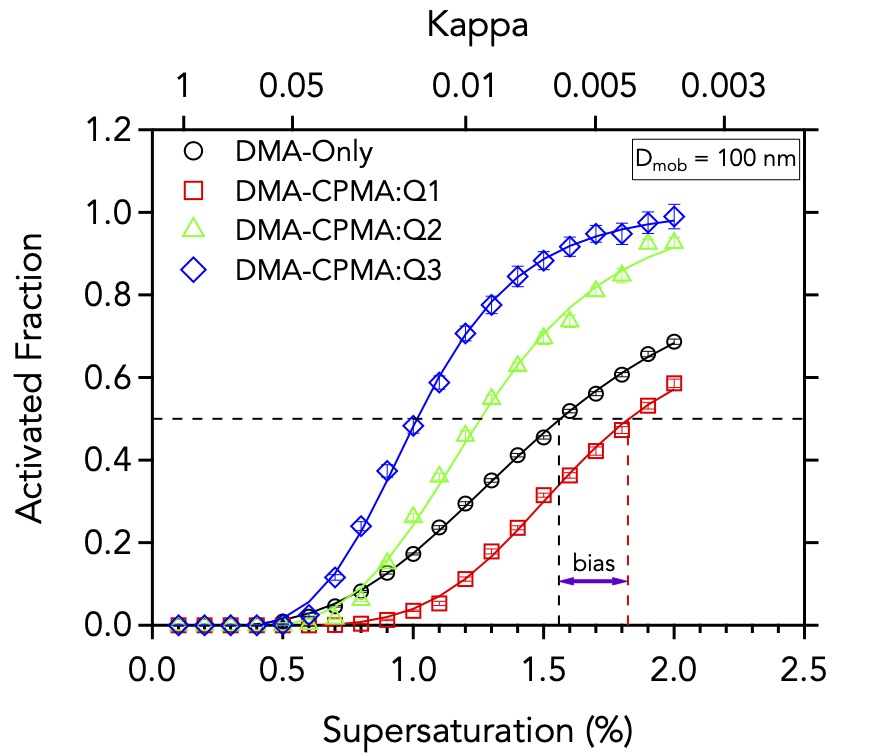Understanding measurement uncertainties in black carbon-water interactions
Submitter
Enekwizu, Ogochukwu Yvonne
— Brookhaven National Laboratory
Sedlacek, Arthur J
— Brookhaven National Laboratory
Area of Research
Aerosol Properties
Journal Reference
Enekwizu O, J Annis-Mildon, E Lewis, and A Sedlacek. 2024. "Multiple-charging effects on the CCN activity and hygroscopicity of surrogate black carbon particles." Journal of Aerosol Science, 182, 106457, 10.1016/j.jaerosci.2024.106457.
Science

Figure 2. Activated fraction of Regal Black as a function of supersaturation for 100-nm electrical mobility diameter particles. Black circles represent particles that were selected by the DMA-only system (and hence include multiply charged particles). Activated fractions for Q1, Q2, and Q3 particles selected by the DMA-CPMA system are shown as red squares, green triangles, and blue diamonds, respectively. Solid lines represent sigmoidal fits. Dashed vertical lines denote the critical supersaturation (sc) for particles selected by the DMA-only system (black) and for Q1 particles selected by the DMA-CPMA system (red). Corresponding hygroscopicity parameters (k) are shown on the upper axis. Image from journal.

Figure 1. Mass distribution of number concentration for Regal Black in the representation dN/dlogM vs. mass-to-charge ratio (M/Q) for 100-nm electrical mobility diameter particles. Solid lines represent lognormal fits to measured data for Q1 (red), Q2 (green), and Q3 (blue) modes. Image from journal.
Accurate measurements of cloud activation properties and hygroscopicity of black carbon (BC) particles are particularly important because of their positive climate forcing. Biases in cloud activation properties and hygroscopicity caused by the presence of larger, multiply charged particles are resolved using the combination of an electrical mobility (DMA) and mass (CPMA) system to select only singly charged particles.
Impact
Our research highlights the advantage of the DMA-CPMA system over the commonly used single DMA system in reducing errors in measurements of CCN activation and hygroscopicity introduced by multiply charged particles. We also introduce the concept of morphology dispersion – variability in aerosol properties resulting from different shapes of particles with the same electrical mobility and mass – and its influence on the multiple charging effects of surrogate BC particles with aggregate morphology.
Summary
Measurements of cloud condensation nuclei (CCN) activity and hygroscopicity of black carbon are typically conducted on particles selected by a differential mobility analyzer (DMA), which also transmits larger, multiply charged particles (Q2s, Q3s, and higher) that have the same electrical mobility as smaller, singly charged particles (Q1s). These larger particles activate at lower supersaturations than the singly charged particles, biasing measurements and resulting in overestimation of CCN activity and hygroscopicity parameter (κ). To reduce errors caused by these multiply charged particles, we employed a centrifugal particle mass analyzer (CPMA) in tandem with a DMA to select only singly charged particles for three commonly used BC surrogates: nigrosin, Regal Black, and fullerene soot. The contribution of the multiply charged particles to the measured activation profiles depended on the underlying incoming particle size distribution, the selected electrical mobility diameter, and the type of the BC surrogate. The morphology dispersion was greatest for fullerene soot, which has a branched aggregate structure. Our findings demonstrate that using the DMA system alone is unlikely to lead to accurate results in measurements of CCN activation and hygroscopicity of BC particles.
Keep up with the Atmospheric Observer
Updates on ARM news, events, and opportunities delivered to your inbox
ARM User Profile
ARM welcomes users from all institutions and nations. A free ARM user account is needed to access ARM data.


















